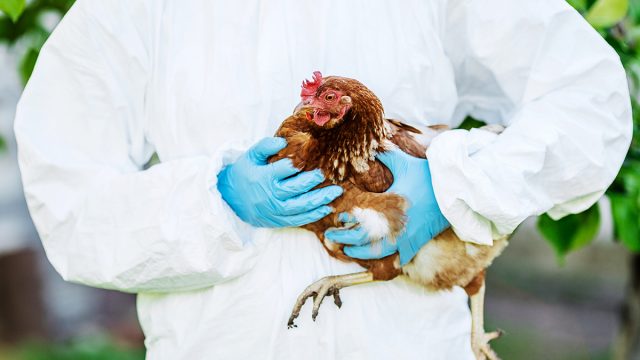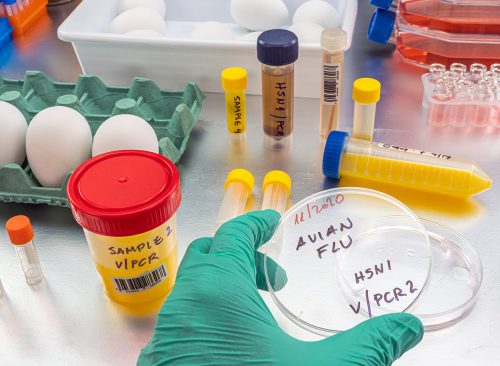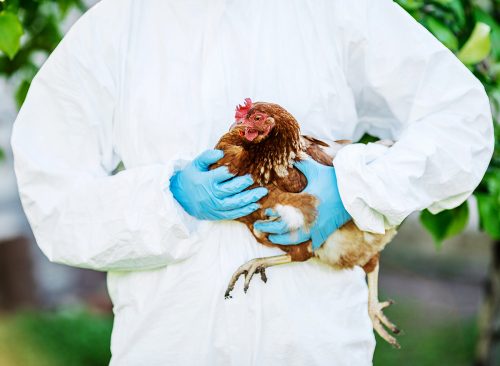Scientists Are Close to Creating Genetically-Edited Chickens That are Resistant to Bird Flu and Could Prevent Egg Shortages
Gene editing knocks out virus.

Scientists say they’re close to creating chickens that are genetically modified to prevent bird flu, potentially putting an end to poultry and egg shortages. It’s likely welcome news to American farmers, who are currently battling the country’s deadliest outbreak of bird flu ever.
Scientists at the Roslin Institute at the University of Edinburgh—which also produced Dolly the first cloned sheep—and Imperial College announced that tantalizing possibility this week, saying they’ve used gene-editing techniques to prevent the destructive virus from reproducing in cells. Read on to find out how they did it, and when the high-tech chickens may be available on store shelves.
RELATED: The 10 Most “OMG” Science Discoveries of 2022

In 2019, the research team used the genome-editing technique CRISPR to delete a piece of chicken DNA that the bird-flu virus uses to replicate. This genetic change inactivated the virus by making it impossible to grow inside cells that had been edited. Scientists are now attempting to replicate those results in a live animal. But it may take years for the genetically edited birds to hit store shelves.

“We have been working on this project since those first results were published back in 2019 and we have results,” said Mike McGrew, group leader at the Roslin Institute. “These are described in a scientific paper that is currently under review in a journal.”
“Breeding a chicken that is completely resistant to infection by avian influenza viruses is a scientific challenge and the research into the efficacy of any genetic resistance must be carefully developed,” he added. “If a resistant chicken were developed it would take five to 10 years before the genetic change was introduced into production flocks of chickens.”

The development may come as welcome news to the nation’s farmers, who are battling a record-setting outbreak of bird flu, and shoppers, who are likely to see rising prices for eggs and poultry—along with smaller supplies on grocery store shelves. In Nebraska, egg production is down 25% since last year, Nebraska Public Media reported this week.
“The demand for eggs usually goes up this time of year,” Sheila Purdum, a professor of poultry science at the University of Nebraska-Lincoln. “And we just haven’t had enough supply to meet that demand. It’s not a panic type of shortage. It’s just the fact that eggs are tight in the marketplace right now.” It takes farmers about six months to replenish their stocks, so the shortage is likely to continue through March 2023.

The bird flu outbreak that’s raging in the U.S. is the nation’s deadliest yet. As of Monday, 52.5 million birds have died of avian influenza, says the Centers for Disease Control and Prevention. Infected birds are culled to prevent spreading the disease. It’s believed that the outbreak started last January when bird flu was detected for the first time since 2015 in wild birds in North Carolina.
“There are multiple versions of influenza, some that infect humans, some that infect animals,” epidemiologist Dr. John Brownstein told ABC News. “It’s been something we’ve been monitoring for two decades now and it creates a real problem, not only for wildlife but it can have dramatic impacts on domestic stock.” He added, “Because this virus is so contagious, drastic measures have to be put into place to stop the spread, and that ultimately results in the death of millions of birds.”

It’s rare for bird flu to spread from animals to humans. During the current outbreak, only one case has been reported, in a Colorado resident who had direct contact with chickens. According to the CDC, the virus can spread when it’s airborne and makes contact with a person’s eyes, nose or mouth, or is inhaled. It is not possible to contract bird flu from eating eggs or chicken meat.
In a Nov. 3 update, the CDC urged Americans to take “preventative measures” against bird flu, such as avoiding direct contact with wild birds and unprotected contact with poultry, to prevent spreading the virus. “This applies not just to workplace or wildlife settings, but potentially to household settings where people have backyard flocks or pet birds with potential exposures to wild or domestic infected birds,” the agency said.














